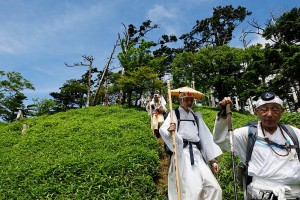Article link: http://thediplomat.com/2016/09/the-mountain-monks-of-japan/
Shugendo and the Yamabushi
Shugendo, or “the way of testing and training”, is an amalgamation of several religions that emerged between twelfth and fourteenth century. Followers of Shugendo who carry out pilgrimages into mountains are known as Yamabushi or “one who prostrates upon mountains”. Shugendo is described as a form of experimental awakening as practitioners gain enlightenment not through reading texts or meditation in temples but though real experiences gained through rituals and going outside into the mountains and immersing oneself in nature. Rituals by the Yamabushi range from fasting, water purification and most notably pilgrimages to the mountains.
Mountain pilgrimage
The pilgrimages are very different from recreational mountain hiking. In the latter, climbers may be more focused on testing their physical abilities or enjoying the scenery. For the Yamabushi, the pilgrimages are spiritual rituals with specific attire and actions to be taken with the goal of attaining enlightenment. Rituals are often used in Japan to mediate the boundary between society and nature especially since nature is closely tied to spirituality and religion in the country (Kalland, 1997). For the Yamabushi, the ritual of pilgrimages into the mountain bring them into nature which symbolises a spiritual realm. Meanwhile human settlements such as cities can be described as what is known and complement to the spiritual realm or the unknown. This differentiation between human settlements and the mountains highlights the importance of the mountain as the location for the pilgrimage. The mountain is a transitional space between the known and unknown therefore functions as a space where self-discovery can occur. A pilgrimage through the city would lack the same symbolism.
Along with other rituals which include standing under a freezing cold waterfall and walking over hot coals, the pilgrimages emphasises on enduring hardship and pain. Walker (2010) argued that pain reminds us of our connection with nature and in the case of the Yamabushi, pain and hardship appears to be used for the purpose of connecting the Yamabushi to nature. The desire to endure pain may be parallel to the desire to leave behind worldly concerns and by successfully overcoming pain, it is symbolic of transcending the regular man and attaining a higher state of body and mind. However it is unclear if pain is still felt at this transcended state.
Shugendo Today
Most practitioners of Shugendo today are middle-aged or older men and are regular people with regular jobs and families therefore most pilgrimages and rituals are carried out over weekends or long holidays. This shows a pragmatic take on allocating time between work, home and religion. Two large centers for Shugendo have also opened their doors to women who were previously excluded from practicing Shugendo. Some temples even organise Shogendo ‘tasters’ for those interested although only through full training does one get ordained. Thus Shugendo may also be a way to package and market nature as a place of rigorous spiritual training as compared to the more comfortable relaxing onsens.
References
Kalland, A., & Asquith, P. J. (1997). Japanese perceptions of nature. Japanese images of nature: Cultural perspectives.
Miyamoto, K. (n.d). “Shugendō” Retrieved from http://k-amc.kokugakuin.ac.jp/
Walker, Brett L. (2010). “Toxic archipelago.”

Interesting and relevant article. “Fans” of Japanese spirituality often are drawn to the yamabushi and their rituals, such as the icy waterfalls and the long mountain hikes. The importance of nature – not miniaturized and controlled, but slightly wild and dangerous – is clear in this case, thus complicating the conclusions of Kirby and others. Yamabushi rituals provide an excellent example of the use of nature-as-pain in spiritual life. The introduction of shugendo “tasters” mirrors the commodification of rural life through apple-picking and rice-planting day trips. It makes one wonder what the more serious yamabushi think of such shugendo tourists.